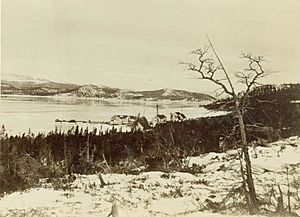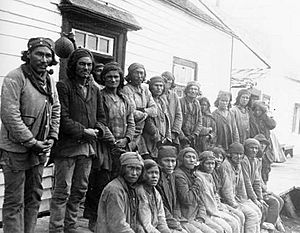Davis Inlet facts for kids
Davis Inlet was a community in Newfoundland and Labrador, a Canadian province. It was once home to the Mushuau Innu First Nation, who are part of the Naskapi people. The community was named after a nearby fjord, which was itself named after the English explorer, John Davis. In 1587, John Davis explored this area while trying to find the Northwest Passage, a sea route to the Pacific Ocean.
In 2002, the people living in Davis Inlet moved to a new community called Natuashish, which is about 15 kilometers away.
Why Davis Inlet Was Settled
The community of Davis Inlet began around 1924. At this time, there weren't many caribou (a type of deer) for the Innu people to hunt. Because of this, the Innu started spending their summers along the coast of Davis Inlet.
This spot was a good choice for several reasons. It was easy to reach, and it offered other food sources besides caribou. There was also a trading post run by the Hudson's Bay Company. Here, the Innu could trade furs for things like traps, ammunition, tobacco, butter, sugar, and flour. Roman Catholic missionaries also visited Davis Inlet, and the Innu found them helpful.
Over the next few years, the Innu began to change their way of life. They slowly moved from being nomads (people who move from place to place) to living in a more settled way. They would still travel inland to hunt caribou in the fall and winter, but they spent their summers at Davis Inlet.
In 1948, the Newfoundland government decided to move the Innu of Davis Inlet. They promised better chances for fishing and hunting in a small community called Nutak in northern Labrador. However, just two years later, the Innu surprised government officials by walking all the way back to Davis Inlet through the Labrador wilderness.
The government still thought about moving the Innu. In 1967, with encouragement from government officials and missionaries, the Innu of Davis Inlet moved again. They settled on Iluikoyak Island and began living there all year round. This is how the permanent Davis Inlet community, known as Utshimasits by the Innu, was established.
Challenges in the New Community
Problems with the new location on Iluikoyak Island started as early as 1969. Living on the island made it hard for the Innu to continue their traditional way of getting food by hunting caribou on the mainland. The community found it difficult to get used to relying on food bought from stores.
Iluikoyak Island is mostly solid rock. Because it was too expensive to dig into the rock, the houses provided by the government were built without basements. They also didn't have proper water or sewage systems. The houses were small, not built very well, and not designed for large extended families to live in together.
Soon, people discovered that there wasn't enough clean water on the island, and most of the water was contaminated. Waste started to pile up, and diseases like tuberculosis began to appear.
Because of negative news reports about the conditions, the Canadian government agreed to move the Innu to mainland Labrador. In 2002, at a cost of almost $200 million, the community of Davis Inlet was moved to Natuashish.
See also
- Drum circle
- Katipenimitak
- Shaking Tent Ceremony



